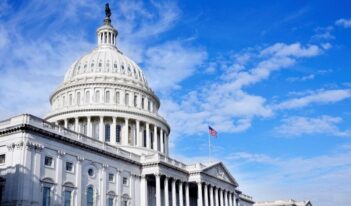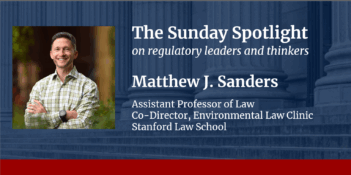
Supreme Court decision hinders but does not halt agency action to address climate change.
Electricity generating plants produce enormous amounts of carbon dioxide and thus account for approximately one-quarter of America’s emissions of greenhouse gases that cause global warming. The U.S. Environmental Protection Agency’s (EPA) Clean Power Plan sought to reduce these emissions by shifting utility generation systems toward using cleaner means of making electricity.
EPA issued the Clean Power Plan in 2015. The Supreme Court then took the extraordinary step of staying the Plan’s implementation. That made it clear that a majority of justices believed that EPA lacked the legal authority to adopt it. Due to President Donald J. Trump’s appointments, the Court has become only more conservative since then. So the Court’s recent decision in West Virginia v. EPA to invalidate the Plan is no surprise. But the Court’s approach represents unwarranted judicial activism.
First, the Court should not have decided the case. Strictly speaking, the Court was reviewing the D.C. Circuit’s decision to set aside the Trump Administration’s rewrite—which amounted to a withdrawal—of the Clean Power Plan. But the Biden Administration was not going to implement that rewrite even if held valid, and the invalidation of the Trump Administration rewrite would not have revived the Plan. Thus, as Justice Elena Kagan noted in her dissent, the Court’s decision amounted to an advisory opinion, something the Supreme Court has always stressed that it does not give.
Second, the Court took an incorrect approach to the merits. The central question was the meaning of the term “best system of emission reduction” in section 111 of the Clean Air Act. Does section 111 allow EPA only to require emissions control within sources’ fencelines, that is, to establish emission limits that compel source owners to take steps within their plants to limit emissions, such as by installing control equipment or adopting cleaner production processes? Or can EPA compel utility systems to move toward a cleaner mix of generating facilities such as by reducing the use of coal-fired plants and increasing the use of renewables such as wind and solar?
This question is a close one. The Plan was based on section 111(d) of the Act. This provision, enacted as part of the Clean Air Act Amendments of 1970, requires EPA to regulate existing air pollution sources in source categories, such as electricity generating plants, for which EPA has promulgated technology-based emission standards for new sources. Section 111(d) standards cover pollutants not controlled under other portions of the Act.
On the one hand, the phrase “best system of emission reduction” is a broad one that arguably includes all types of measures that can reasonably be said to be feasible. On the other hand, there is no evidence that Congress meant section 111(d) to be anything other than interstitial, and the provision has never been used for anything even remotely as important as regulating emissions of greenhouse gases, much less to do more than require controls within a plant. Indeed, David Doniger of the Natural Resources Defense Council—which did much to develop the concepts underlying the Clean Power Plan—called section 111(d) “the 40-year-old virgin” of the Clean Air Act. Thus, a plausible case can be made that section 111(d) does not authorize the Plan.
But instead of using the usual tools of statutory interpretation, the Court expanded its recently developed “major questions” doctrine that prohibits an administrative agency like EPA from launching a novel major program without “clear Congressional authorization.” That doctrine has far-reaching effects going beyond environmental law. But it lacks foundation in any but the Court’s most recent precedents.
Moreover, the “major questions” doctrine is irrelevant to this case. Unlike previous decisions in which the Court used the doctrine, the Clean Power Plan did not involve an agency regulating outside its area of expertise or reversing a fundamental legal interpretation. EPA, after all, has a half-century of experience in regulating air pollution from electricity generators. Nor was the Plan “major” in its regulatory impact. The emission reduction goals of the Plan were sufficiently modest that market forces accomplished them without the Plan ever being implemented.
The doctrine is especially inappropriate when it comes to global warming. Agencies like EPA should not, of course, be allowed to exceed the bounds that Congress set for them. But these bounds should be interpreted wherever reasonable in ways that make it possible to deal with such a profound threat to our well-being.
But the decision does not doom efforts to slash the emissions causing global warming. EPA can still require existing sources to control emissions within their fencelines so long as EPA can reasonably show its requirements to be achievable. Such means of control for electricity generating facilities—most prominently, carbon capture and sequestration underground—may become available soon.
Similarly, the Court’s opinion does not stop EPA from proceeding with its proposals to require that existing and new oil and gas facilities control leaks of methane, a major cause of global warming, or to mandate reductions in the production and use of hydrofluorocarbons, a class of potent greenhouse gases. Nor does the decision prevent the Biden Administration from continuing to establish fuel economy standards that force auto manufacturers to move toward hybrid or electric vehicles.
Moreover, much can be done without regulation. The market forces that are pushing the electricity generating system toward renewables have been buttressed by the tax incentives recently enacted by Congress. The federal government can make the electric grid friendlier to renewable energy by, for instance, facilitating the use of federal lands for location of transmission lines to link generators using wind or solar to the grid. It can also remove obstacles to importing solar panels.
The Court’s decision, though, reinforces the importance of congressional action to combat climate change. The Administration is limited until Congress enacts an emission tax or a cap-and-trade scheme that puts a price on emitting greenhouse gases, as advocated by economists, or increases EPA’s authority to regulate emissions of greenhouse gases. The next Congress will likely be even less open than the present one to doing either. Still, the Court’s decision leaves considerable scope for agency action until Congress can be persuaded to act.
In the end, the Court’s decision damages efforts to control greenhouse gases. But it does not doom those efforts.




